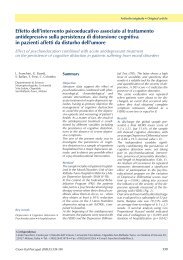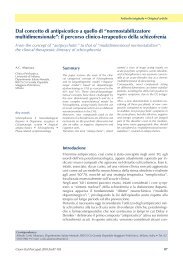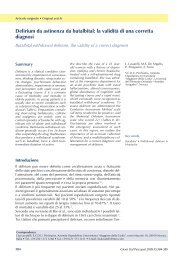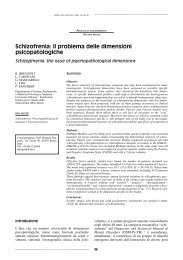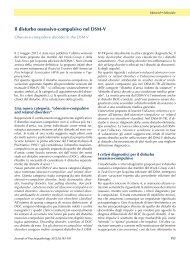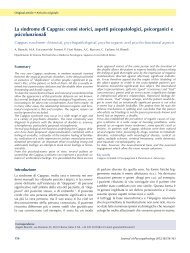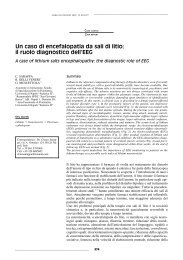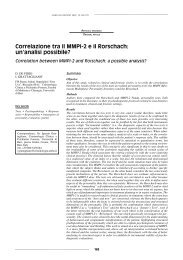XI Congresso della Società Italiana di Psicopatologia Psichiatria ...
XI Congresso della Società Italiana di Psicopatologia Psichiatria ...
XI Congresso della Società Italiana di Psicopatologia Psichiatria ...
You also want an ePaper? Increase the reach of your titles
YUMPU automatically turns print PDFs into web optimized ePapers that Google loves.
Reference<br />
1 Isacsson G. Suicide prevention – a me<strong>di</strong>cal breakthrough? Acta<br />
Psychiatr Scand 2000;102:113-7.<br />
2 Olfson M, Shaffer D, Marcus SC, Greenberg T. Relationship between<br />
antidepressant me<strong>di</strong>cation treatment and suicide in adolescents.<br />
Arch Gen Psychiatry 2003;60:978-82.<br />
3 Isacsson G, Holmgren P, Ahlner J. Selective serotonin reuptake<br />
inhibitor antidepressants and the risk of suicide: a controlled<br />
forensic database study of 14 857 suicides. Acta Psychiatr Scand<br />
2005;111:286-90.<br />
Neurobiologic basis for suicide:<br />
new fin<strong>di</strong>ngs<br />
SIMPOSI TEMATICI<br />
J.J. Mann<br />
Department of Psychiatry, Columbia University; Department<br />
of Neuroscience, NYS Psychiatric Institute, New York<br />
Stu<strong>di</strong>es of the neurobiologic correlates of suicide have<br />
largely focused on postmortem brain analyses. An initial<br />
breakthrough set of stu<strong>di</strong>es employed autora<strong>di</strong>ography to<br />
map receptor changes throughout the brain in suicides.<br />
These mapping stu<strong>di</strong>es were able to show that serotonin<br />
receptor changes associated with suicide, in contrast to<br />
mood <strong>di</strong>sorders, were localized to the ventral prefrontal<br />
cortex.<br />
This linked deficient serotonergic input to decision making<br />
and impulsiveness which involves the ventral prefrontal<br />
cortex.<br />
More recently, stu<strong>di</strong>es have examined the serotonin neuron<br />
cell bo<strong>di</strong>es in the raphe nuclei in the brainstem. Those<br />
stu<strong>di</strong>es have shown that there are more serotonin neurons<br />
and that both the protein and messenger RNA for tryptophan<br />
hydroxylase 2, the rate-limiting biosynthetic enzyme<br />
for serotonin, are higher in the raphe nuclei of suicides.<br />
Conversely, 5-HT 1A autoreceptor bin<strong>di</strong>ng and message are<br />
lower. These changes are consistent with upregulation of<br />
serotonin neuron function and therefore potential homeostatic<br />
responses to low serotonin release.<br />
These brainstem changes may be due to suicide or may be<br />
due to mood <strong>di</strong>sorders, which frequently underlies suicidal<br />
behavior. That question remains to be resolved.<br />
Other changes that have been observed in suicide victims<br />
involve alterations in noradrenergic and dopaminergic<br />
function as well as in second messenger responses in the<br />
cortex. Blunted second messenger responses in relation to<br />
the 5-HT 1A and 5-HT 2A receptor populations are present<br />
and may represent a second abnormality at the level of<br />
signal transduction related to suicide.<br />
Again, these stu<strong>di</strong>es only partly resolve the question of<br />
whether these changes are related to depression or mood<br />
<strong>di</strong>sorders, or with suicide. These fin<strong>di</strong>ngs in monoamine<br />
systems may also be associated with functional variants in<br />
can<strong>di</strong>date genes and represent developmental effects.<br />
There will be some <strong>di</strong>scussion of those associations with<br />
genes and childhood adversity.<br />
Trends in suicide rates: an international<br />
perspective<br />
L. Tondo * ** *** , R.J. Baldessarini **<br />
* Dipartimento Psicologia, Università <strong>di</strong> Cagliari; ** Department<br />
of Psychiatry, Harvard Me<strong>di</strong>cal School,<br />
“McLean” Division of Massachusetts General Hospital;<br />
*** Centro “Bini”, Cagliari<br />
Introduction: annual suicide rates per 100,000 population<br />
vary widely among countries, probably due in part to <strong>di</strong>ssimilar<br />
case-ascertainment and reporting procedures. Nevertheless,<br />
even among countries expected to have relatively<br />
reliable data, recent suicide rates vary enormously, from<br />
over 29 in Hungary to as low as 3.5 in Greece. Suicide rates<br />
also show notable secular fluctuations within countries.<br />
However, average international rates have been quite stable<br />
over the last 50 years, at approximately 13.0. Suicide has<br />
been associated with psychiatric <strong>di</strong>sorders in about 90% of<br />
cases evaluated postmortem, and depressive or mixed dysphoric-agitated<br />
mood states account for about 80% of cases.<br />
It is surprising, therefore, that during the last half-century<br />
major changes in the level of clinical and social awareness<br />
of depressive illness as well as advances in pharmacological<br />
and psychosocial treatments for mood and other psychiatric<br />
<strong>di</strong>sorders appear to have contributed little to decrease the incidence<br />
of suicide. We now report on fin<strong>di</strong>ngs pertaining to<br />
international trends in suicide rates.<br />
Methods: we collected data from WHO (www.who.org) on<br />
national suicide rates from 24 representative countries, provi<strong>di</strong>ng<br />
rates for men and women every five-years from the<br />
1950s to 2000, and calculated percent change from 1950 or<br />
the earliest reported year. Encouraged by stu<strong>di</strong>es suggesting<br />
an association of decreasing suicide rates with increasing<br />
use of antidepressants in recent decades in some Western<br />
countries, we hypothesized that widespread acceptance of<br />
the tricyclic antidepressants (TCAs) in the 1970s, and their<br />
replacement by the serotonin-reuptake inhibitors (SRIs) and<br />
other modern antidepressants in the 1990s might be reflected<br />
in changes in suicide rates as either universal or regional<br />
trends.<br />
Results: changes in international suicide rates over the past<br />
half-century range from an 80% decrease in Portugal to an<br />
80% increase in Ireland (likely an artifact of increased report<br />
after decriminalization of suicide there in 1991), with a minor,<br />
highly variable average increase of 3.32 ± 0.1% over the<br />
half-century. Changes between 1990 and 2000 range from a<br />
decrease of 73% in Portugal to an increase of 35% in Japan,<br />
but yield a statistically significant average decrease of 14.9%<br />
± 25.4, with marked <strong>di</strong>fferences among world regions.<br />
Conclusions: these fin<strong>di</strong>ngs suggest that average international<br />
suicide rates have been quite stable over the last 50<br />
years but with striking variations between, and substantial<br />
shifts within countries. There has been a tendency to attribute<br />
moderate reported decreases in suicide rates, particularly<br />
among younger age groups in Northern Europe and<br />
North America, to greater acceptance of relatively safe modern<br />
antidepressants over the past decade. However, such<br />
trends often were identifiable well before widespread clinical<br />
use of SSRIs and other modern antidepressants. Moreover,<br />
such ecological analyses of population trends should<br />
be considered with great caution since they may not reflect<br />
202




